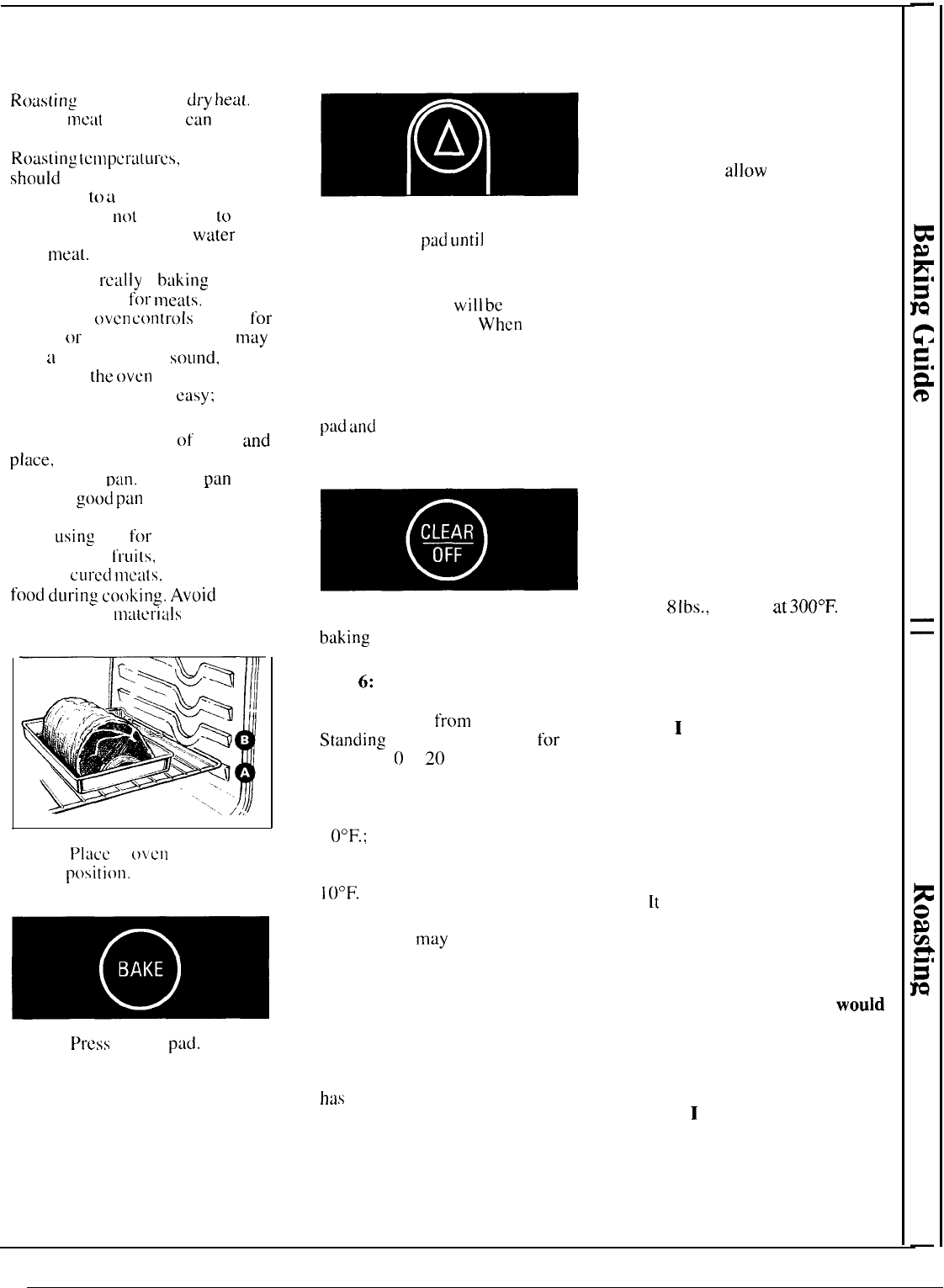
Roasting
Rotisting
is cooking by
dry
heal.
Tender
meat
or poultry
can
be
roasted uncovered in your oven.
Roas[ing
~enlpcraturcs,
which
should
be low and steady, keep
spattering
to
u
minimum. When
roasting. it is
not
necessary
10
sear, baste, cover or add
water
to
your
meal.
Roasting is
really
a
baking
procedure used
for
mea[s.
Therefore,
oven
controls
are set
for
BAKE
or
TIME BAKE. (You
may
hear
a
slight clicking
s(~llnd,
indicating
the
oven
is working
properly. ) Roasting is
easy;
just
follow these steps:
Step 1: Check weight of meat,
and
place,
fat side up. on roasting rack
in a shallow
~an.
(Broiler
pan
with
.
rack is a
good
pan
for this. ) Line
broiler pan with aluminum toil
when
using
pan
for
marinating,
cooking with
I’rui[s,
cooking
heavily
CLIrCd
meats,
or basting
food”
during
cooking.
Avc)id
spilling these
matcriats
on oven
liner or door.
Step 2:
Ptacc
in olcn on shelf in
A or B
pc~sition,
No preheating
is necessary.
-
:A
Step 3:
Press
BAKE
p~d.
Step 4: Press INCREASE or
DECREASE
pad
until
desired
temperature is displayed.
The word “ON” and the changing
oven temperature
witt
be
displayed
as the oven heats up.
When
the
oven reaches the set temperature a
tone will sound.
To change oven temperature
during BAKE cycle, press BAKE
pad
and
then INCREASE or
DECREASE pad to get new
temperature.
Step 5: Press CLEAR/OFF when
baking
is finished and then remove
food from oven.
Step
6:
Most meats continue to
cook slightly while standing, after
being removed
from
the oven.
Standin&
time recommended
for
roasts is t
0
to
20
minutes. This
allows roasts to firm up and makes
them easier to carve. Internal
temperature will rise about 5° to
t
O°F.;
to compensate for
temperature rise, if desired, remove
the roast from oven sooner (at 5° to
100F.
less than temperature in the
Roasting Guide).
NOTE: You
may
wish to TIME
BAKE, as described in the Baking
section of this book, to turn oven
on and off automatically.
Remember that food will continue
to cook in the hot oven and
therefore should be removed when
the desired internal temperature
has
been reached.
For Frozen Roasts
● Frozen roasts of beef, pork, lamb,
etc., can be started without
thawing, but
allow
10 to 25
minutes per pound additional time
(10 minutes per pound for roasts
under 5 pounds, more time for
larger roasts).
● Thaw most frozen poultry before
roasting to ensure even doneness.
Some commercial frozen poultry
can be cooked successfully without
thawing. Follow directions given
on package label.
Questions and Answers
Q. Is it necessary to check for
doneness with a meat
thermometer?
A. Checking the finished internal
temperature at the completion of
cooking time is recommended.
Temperatures are shown in the
Roasting
Guide section. For roasts
over
8
Ibs.,
cooked
at
300°F.
with
reduced time, check with
thermometer at half-hour
intervals after half the cooking
time has passed.
Q. Why is my roast crumbling
when
I
try to carve it?
A. Roasts are easier to slice if
allowed to cool 10 to 20 minutes
after removing from oven. Be sure
to cut across the grain of the meat.
Q. Do I need to preheat my oven
each time I cook a roast or
poultry?
A.
[t
is rarely necessary to preheat
your oven. Preheat only for very
small roasts, which cook a short
length of time.
Q. When buying a roast, are
there any special tips that
would
help me cook it more evenly?
A. Yes. Buy a roast as even in
thickness as possible, or buy
rolled roasts.
Q. Can
I
seal the sides of my foil
“tent”
when roasting a turkey?
A. Sealing the foil will steam the
meat. Leaving it unsealed allows the
air to circulate and brown the meat.
19


















